原文地址:http://blog.callmewhy.com/2014/10/08/uialertcontroller-swift-closures-enum/
在 iOS8 的 SDK 中, UIKit 框架里两个常用的 API 有了比较大的改动。UIActionSheet 和 UIAlertView 都被 UIAlertController 替换了。
在 iOS8 里,如果你想要弹出消息,你应该使用 UIAlertController 而不是那两个不建议使用的类了。 ActionSheet 和 AlertView 都变成了 UIAlertController 的风格。在创建 UIAlertController 的时候你可以选择不同的风格,按钮事件的处理方法也重新设计了,不再需要像以前那样使用 delegate 处理用户操作。当使用 UIAlertController 的时候,你可以把事件和控制器关联起来,事件在 Objective-C 中是一个 block 而在 Swift 中则是一个闭包 (closure)。
在这篇教程里,我们将会介绍 UIAlertController 并且演示如何使用它来弹出消息和表单。借此机会,我刚好简单的讲解一些 Swift 中闭包和枚举的内容。
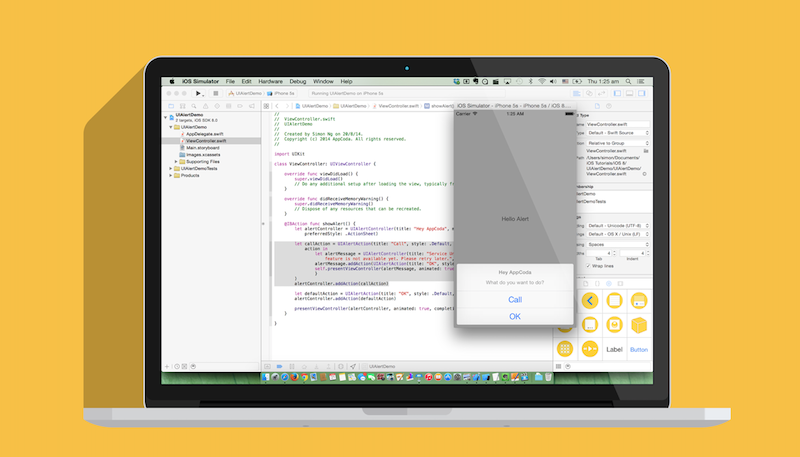
创建 Xcode 项目
通过项目来学习是最好的方法,我们新建一个 Single View Application 的项目并将其命名为 UIAlertDemo 。记得选中 Swift 作为默认的开发语言。
在 Xcode6 中, Size Class 是默认开启的状态,为了让代码尽量的简单易懂,在此教程中我们不会使用相关的新特性,选中 Main.storyboard 文件并且在属性中去掉 Use Size Classes 的勾选。取消勾选之后会提醒选择默认设备类型,选中 iPhone 并且点击 Disable Size Classes 即可。这样我们的 ViewController 看起来就是 iPhone 的尺寸了。
拖拽一个按钮到视图中并且设置标题为 Hello Alert ,这样就完成了前戏准备工作。
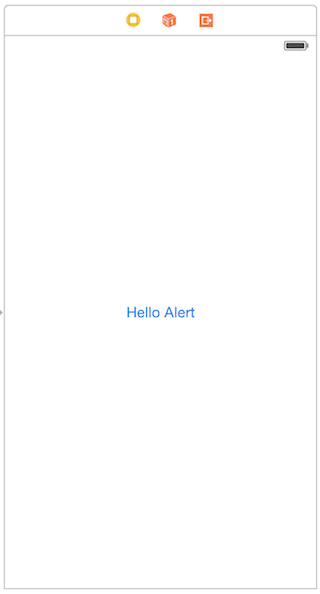
添加 Action 方法
在 ViewController.swift 里,为按钮添加一个方法,接下来我们会将它和 Storyboard 关联起来:
@IBAction func showAlert() {
}
Outlet 和 Action 让我们可以把源码和 UI 对象关联起来,在 Swift 里,我们在方法名前添加 @IBAction 关键字,表明这是一个 Action 方法。这个方法将会和 Storyboard 关联起来。
接下来我们将会把按钮和方法关联起来。在左侧的缩略图中,按住 Control 键并从按钮拖拽到 ViewController 上,松开按钮,选择 showAlert 方法:
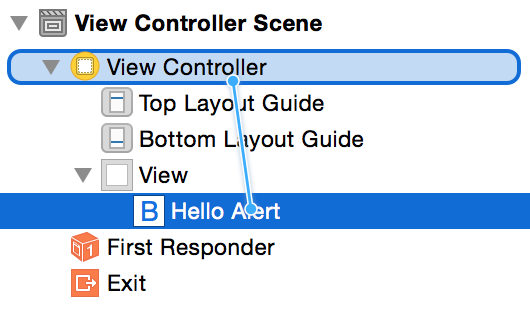
使用 UIAlertViewController 弹框
我们已经完成了基本的项目配置,现在可以开始学习 UIAlertController 类的使用了。大致来说,为了弹出提示信息,大致需要完成以下几个步骤:
- 创建一个 UIAlertController ,设置它的标题、内容以及式样。
- 定义 UIAlertAction 对象,并且把它加到 AlertController 中。
- 通过调用
presentViewController方法弹出内容。
如果用 Swift 写,看起来大概是这个样子的:
@IBAction func showAlert() {
let alertController = UIAlertController(title: "Hey AppCoda", message: "What do you want to do?", preferredStyle: .Alert)
let defaultAction = UIAlertAction(title: "OK", style: .Default, handler: nil)
alertController.addAction(defaultAction)
presentViewController(alertController, animated: true, completion: nil)
}
很简单,不是吗?我们只需要设定 Style 值就可以选择弹出的是消息还是表单。如果是 .Alert 则是弹出消息,.ActionSheet 则对应表单。
默认情况下, AlertController 并没有和任何 Action 关联起来。如果你没有添加任何 Action 会导致无法关闭弹出的内容。在上面的代码中,我们创建了一个 UIAlertAction 的实例,并且通过 addAction 方法把它和 AlertController关联起来。在初始化 UIAlertAction 的时候,你需要指定标题 (Title),样式 (Style) 和处理器 (Handler) 。Handler 是一个代码块,会在按钮被点击的时候执行。我们只需要把 Handler 设置成 nil 就可以关闭弹出的窗口。在后面的内容里会有详细的讲解。
最后,我们调用 presentViewController 方法弹出页面,如果你运行一下示例程序,点击按钮你会得到一个弹出的消息 (取决于你设定的样式) :
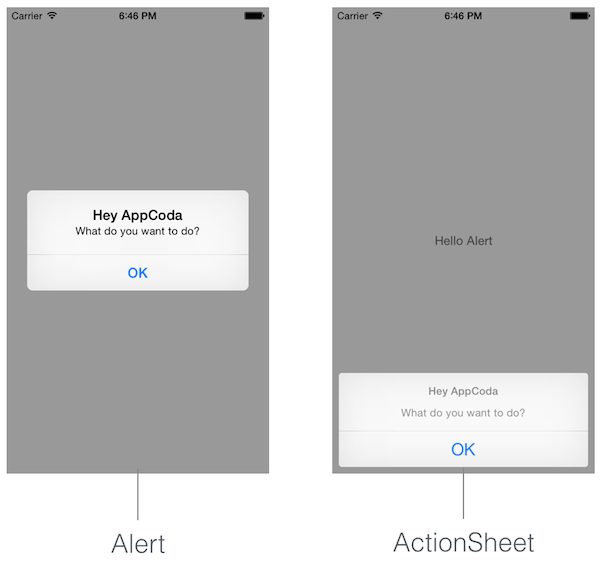
简要的谈谈 Swift 中的枚举
如果你是第一次编写 Swift 的代码,你可能不太熟悉在设定样式时使用的 . 语法。你可以这样重写一下前面的代码:
let alertController = UIAlertController(title: "Hey AppCoda", message: "What do you want to do?", preferredStyle: UIAlertControllerStyle.Alert)
代码是完全一样的,我们只是准确的指定了枚举类型, UIAlertControllerStyle 实际上是一个枚举类:
enum UIAlertControllerStyle : Int {
case ActionSheet
case Alert
}
Swift 中的枚举类型可以让你把相关的值放到一个组里,枚举中定义的值 (例如: AlertSheet 和 Alert) 就是成员的值。 Objective-C 里,成员在创建的时候会指定一个常量值,比如0和1,而 Swift 中则不是这样。以 UIAlertControllerStyle 为例, ActionSheet 和 Alert 并没有定义为0和1,每个成员在枚举中都是完整的值。
你可以通过枚举类型 (比如 UIAlertControllerStyle) 加上点和成员值的方式来指定枚举值。UIAlertControllerStyle.Alert 就是一个典型的例子。得益于 [Swift 的类型推导特性],我们在指定枚举值的时候可以去掉前面的枚举类型,这也就是为什么可以写作 .Alert 和 .ActionSheet 的原因。
let alertController = UIAlertController(title: "Hey AppCoda", message: "What do you want to do?", preferredStyle: .Alert)
这种缩略形式的点语法可以让你少写代码并且让你的代码更具有可读性。
Handler 和闭包
让我们回到 UIAlertController 里,我们还没有讨论 UIAlertAction 中的 handler 。当我们创建一个 UIAlertAction 的时候,我们可以把一个代码块指定为 handler 。当用户触发了 Action 事件的时候便会执行这段代码。我们可以在 showAlert 方法里插入如下代码添加一个新的 action :
let callActionHandler = { (action:UIAlertAction!) -> Void in
let alertMessage = UIAlertController(title: "Service Unavailable", message: "Sorry, the call feature is not available yet. Please retry later.", preferredStyle: .Alert)
alertMessage.addAction(UIAlertAction(title: "OK", style: .Default, handler: nil))
self.presentViewController(alertMessage, animated: true, completion: nil)
}
let callAction = UIAlertAction(title: "Call", style: .Default, handler: callActionHandler)
alertController.addAction(callAction)
在这里我们添加了一个 callAction 用来弹出提示。在 Swift 里,这样的代码块叫做闭包 (Closure) 。闭包是可传递的功能代码块,很像 Objective-C 中的 block 。正如上面的例子那样,如果想要声明某个 action 的闭包,方法之一是把这个代码块声明成一个常量或者变量。第一个部分定义了 handler 的参数为 UIAlertAction 类型,关键词 in 表明前面的参数和返回类型都已经定义完毕,后面便是闭包的内容:
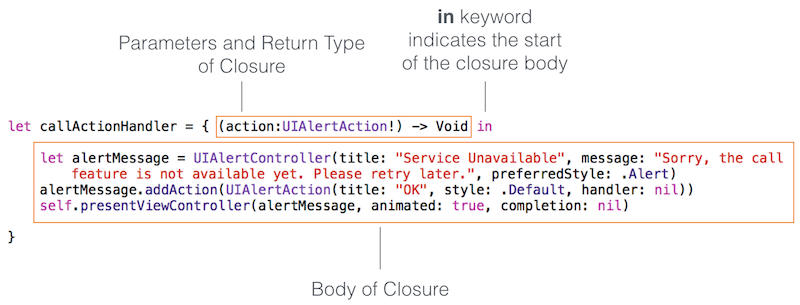
其实我们并没有必要声明一个单独的变量来存储闭包的内容,我们可以直接把闭包作为一个参数传过去。 Swfit 可以推测参数的类型,所以我们可以这样简化代码:
let callAction = UIAlertAction(title: "Call", style: .Default, handler: {
action in
let alertMessage = UIAlertController(title: "Service Unavailable", message: "Sorry, the call feature is not available yet. Please retry later.", preferredStyle: .Alert)
alertMessage.addAction(UIAlertAction(title: "OK", style: .Default, handler: nil))
self.presentViewController(alertMessage, animated: true, completion: nil)
}
)
alertController.addAction(callAction)
总结
通过这篇教程,我希望你能理解 UIAlertController 的基本使用方法。希望你喜欢这个 iOS8 里的新伙计!
你可以在这里下载源码。
原文地址: